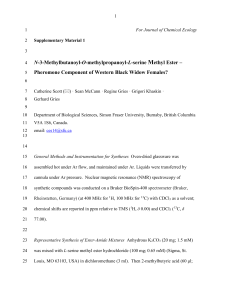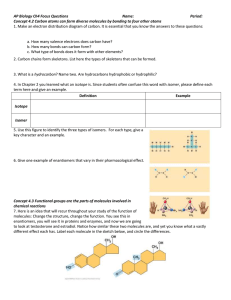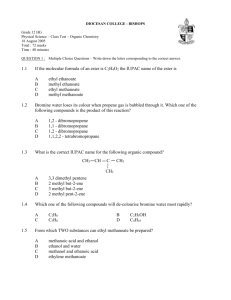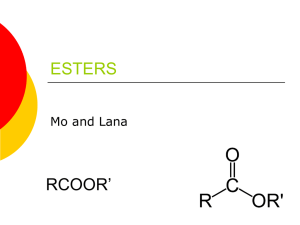-
advertisement
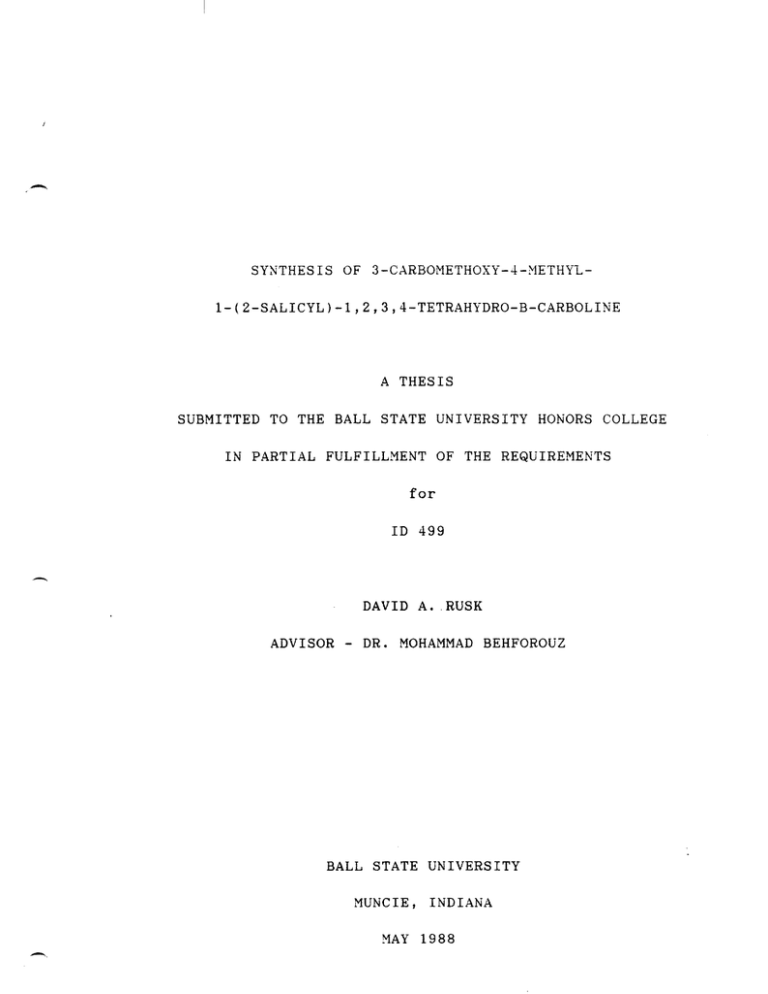
SYNTHESIS OF 3-CARBOMETHOXY-4-METHYL1-(2-SALICYL)-1,2,3,4-TETRAHYDRO-B-CARBOLINE
A THESIS
SUBMITTED TO THE BALL STATE UNIVERSITY HONORS COLLEGE
IN PARTIAL FULFILLMENT OF THE REQUIREMENTS
for
ID 499
DAVID A .. RUSK
ADVISOR - DR. MOHAMMAD BEHFOROUZ
BALL STATE UNIVERSITY
MUNCIE, INDIANA
-.
!-'lAY 1988
_
....-',
SYNTHESIS OF 3-CARBOMETHOXY-4-METHYL1-(2-SALICYL)-1,2,3,4-TETRAHYDRO-B-CARBOLINE
A THESIS
SUBMITTED TO THE BALL STATE UNIVERSITY HONORS COLLEGE
IN PARTIAL FULFILLMENT OF THE REQUIREMENTS
for
ID 499
DAVID A. RUSK
ADVISOR APPROVAL
Advi or
Date
BALL STATE UNIVERSITY
MUNCIE, INDIANA
MAY 1988
-.
ACKNOWLEDGEMENT
I would like to express my deepest appreciation to
Dr. Mohammad Behforouz for his excellent instruction,
advice and assistance, but most importantly, for
allowing me to participate in this project.
I would also like to thank Mr. F. William "Bill"
Bell and Mr. Mark Horn for their help and support and
especially for all of the "little things".
I am especially grateful for the financial support
received from the Ball State Undergraduate Fellows
Program, the Ball State Undergraduate Research Grant
Program, the National Institutes of Health, and the
Petroleum Research Fund.
Finally, I would like to thank my family and
friends who were always their when I needed them the
most~.
-.
TABLE OF CONTENTS
page
HISTORICAL .
1.
II.
.
.
.
.
.
.
.
.
.
.
.
.
.
.
.
.
..
1
BACKGROUND .
1
SYNTHESIS OF B-CARBOLINES .
4
DISCUSSION .
.
.
.
9
PREPARATION OF ISOMER A OF METHYL
3-(3-INDOLYL)-2-NITROBUTANOATE . .
13
PREPARATION OF B-METHYLTRYPTOPHAN
METHYL ESTER .
17
PREPARATION OF N-BENZYLIDENE-B-METHYLTRYPTOPHAN METHYL ESTER .
.
. .
.
.
.
.
18
PREPARATION OF N-BENZYL-B-METHYLTRYPTOPHAN
METHYL ESTER .
18
PREPARATION OF 2-BENZYL-3-CARBOMETHOXY-4METHYL-1-(2-SALICYL)-1,2,3,4-TETRAHYDROB-CARBOLINE
19
PREPARATION OF 3-CARBOMETHOXY-4-METHYL-1(2-SALICYL)-1,2,3,4-TETRAHYDRO-B-CARBOLINE.
20
EXPERIMENTAL .
I.
II.
.
21
GENERAL INFORMATION.
21
PROCEDURE .
23
.
.
.
.
METHYL (2RS, 3SR)-2-NITRO-323
(3-INDOLYL) BUTANOATE . . . .
METHYL (2RS, 3SR)-2-AMINO-3(3-INDOLYL) BUTANOATE . . . .
24
N-BENZYLIDENE-B-METHYLTRYPTOPHAN
METHYL ESTER .
.
.
.
.
.
.
.
26
.
27
N-BENZYL-B-METHYLTRYPTOPHAN
METHYL ESTER .
.
.
.
.
.
.
2-BENZYL-3-CARBOMETHOXY-4-METHYL-1(2-SALICYL)-1,2,3,4-TETRAHYDROB-CARBOLINE .
.
.
.
.
.
.
.
.
.
28
3-CARBOMETHOXY-4-METHYL-1-(2-SALICYL)1,2,3,4-TETRAHYDRO-B-CARBOLINE .
. ..
29
REFERENCES .
31
APPENDIX .
34
.
1
HISTORICAL
I.
BACKGROUND
The chemistry of B-carbolines has been given
considerable attention because of the preponderance of this
nucleus (1) in a large number of natural products.
The
1 ,2
derivatives containing the same system with the pyridine
ring in the reduced state are known as tetrahydro-Bcarbolines (2).3
1
2
These compounds and their derivatives are known to
possess many behavioral and neeurochemical activities.
i
Although these effects are considerably nonspecific, Bcarbolines are known to evoke sedation, hallucinations,
2
convulsions, and tremors and may even playa role in certain
psychological illnesses such as schizophrenia.
3,5
In
addition, there has been speculation that alkaloids
containing the tetrahydro-B-carboline nucleus may function in
moderating the behavioral effects of ethanol use and may even
account for the biochemical mechanisms of the physical
dependence on this drug.
5 ,7
Recently, B-carbolines have come under increased study
because of their interaction with benzodiazepine receptors in
the brain.
Benzodiazepines are a heavily prescribed class of
mild tranquilizers which share a common molecular structure
and similar pharmacological activities. s
These activities
include sedation, muscle relaxation, convulsion prevention,
and anxiety reduction.
As suggested earlier, benzodiazepines
exert their effects by interacting with high affinity binding
sites in the brain; hence, a major area of study has been the
identification of this receptor.
9
Researchers have proposed
that a B-carboline derivative is, in fact,
ligand of the benzodiazepine receptor.
the indigenous
As a result, studies
and the synthesis of B-carbolines and tetrahydro-B-carbolines
3
-
are areas of much research interest.
Pharmacological studies of B-carbolines and their
tetrahydro derivatives indicate that some of these alkaloids
possess affinity for the benzodiazepine binding site, and,
therefore, antagonize the action of these tranquilizers.
This finding in addition to the known activity of
benzodiazepines has led to the speculation that the
benzodiazepine receptor possesses the physiological functions
involving alertness and other psychoneurotic states.
10
Minor changes in the B-carboline structure result in
different affinities to the benzodiazepine receptor.
11
For
example, replacing hydrogen with an R-group at the i-position
of the B-carboline (3) or its tetrahydro derivative (4)
results in a loss of activity.
Q;0-H
I
H
3
R
4
In addition, B-carbolines are more active in their ability to
bind than their corresponding tetrahydro derivative.
3,12
The
investigation of the binding abilities of different Bcarbolines toward the benzodiazepine receptor is still an
area of much interest as indicated by the number of reports
being published in this field.
13 - 15
Similarly, our group is
attempting to synthesize various B-carbolines and their
tetrahydro derivatives.
II.
SYNTHESIS OF B-CARBOLINES
Several procedures have been used for the preparation of
B-carbolines and their 1,2,3,4-tetrahydro derivatives;
however, the most important synthetic method is the PictetSpengler condensation reaction.
1 ,16-19
This involves the
reaction of tryptamines(5a), tryptophans (5b), or tryptophan
methyl esters (5c) with aldehydes (6) to yield the
corresponding tetrahydro-B-carboline (7),
(Eq.
1).1,16,20
5
-
R'
~
~
I \
+
NH2
)ro
RCHO
N....H
R
7
6
5
R'
a,
b,
c,
H
C0 H
2
COlH3
(Eq. 1)
Dehydration of (7) gives the desired B-carboline (8),
(Eq.
2) •
N'H
8
7
(Eq. 2)
Many groups have synthesized a variety of B-carbolines
and their tetrahydro derivatives.
-
21-24
Most of these
6
reactions involved the use of acidic, protic media to carry
out the condensation; however, a major modification of the
Pictet-Spengler condensation has-been reported by Cook and
his co-workers.
25 ,26
They have obtained higher yields of
products when reactions were conducted in refluxing
nonacidic, aprotic media.
For example, the condensation of
tryptophan methyl ester (5c) and benzaldehyde in refluxing
benzene for 48 hours gave the desired tetrahydro-B-carboline
( 9) in 95% yield,
(Eq.
3).
CH
°2 3
+
H
5c
This procedure
6
I~
C6H6
°2CH 3
IP=
h-
9
(Eq. 3)
will not work for some aldehydes such as salicylaldehyde, and
an immine (10) is the product of the condensation,
-.
(Eq.
4).
27
7
-
CHO
C0 2CH 3
cr
+
1.0
H2
H
°2CH 3
OH
)
N:CH-O
H
10
5c
(Eq. 4)
In such cases, an N-benzyl derivative (11) may be used
in the Pictet-Spengler condensation to produce an N-benzyltetrahydro-B-carboline (12) which may then be debenzylated to
obtain the desired tetrahydro-B-carboline (5cl,
RCHO
H
11
)
(Eq. 5).
8
.H
H
13
12
(Eq. 5)
Cook and his co-workers have prepared several B-carbolines
and their tetrahydro derivatives by this method.
27
The purpose of our investigation is to prepare lesser
known B-carbolines and their tetrahydro derivatives having a
methyl substitution at the 4-position by the Pictet-Spengler
condensation of N-benzyl-B-methyltryptophan methyl ester with
aldehydes.
9
DISCUSSION
The major objective of this research was the synthesis
of B-carbolines and their tetrahydro derivatives via a
modified Pictet-Spengler condensation.
Due to time
limitations, only 3-carbomethoxy-4-methyl-1-(2-salicyl)1,2,3,4-tetrahydro-B-carboline (19) and its precursors were
prepared.
These compounds were formed through the
condensation of N-benzyl-B-methyltryptophan methyl ester
(17), prepared by the condensation of B-methyltryptophan
methyl ester (14) with benzaldehyde (15),as shown in Scheme
1.
10.
C0 2CH 3
H2
I
H
14
+
°2CH 3
CHO
6
C6H~
H
15
16
fCHO
cr
OH
J~
h-
xylene
MeOH
17
Pd/C
t
19
18
--
.,-
.....-- --..-....
(Scheme 1)
~
11
-
B-methyltryptophan methyl ester (14) was prepared
according to Scheme 2, which is known as the nitroacetate
method.
2S - 30
20
N0
2
H , Ni
2
H
H
21
14
(Scheme 2)
-
-
12
The stereochemistry of B-methyltryptophan methyl ester
isomers known as A (2SR,3RS racemate,
racemate,
[14a]) and B (2RS,3RS
[14b]) has been determined through nmr studies by
Turchin and co-workers.
31
H H
".. ·.. ·CD CH
2 3
H
14b
14a
Similarly, the stereochemistry of methyl 3-(3-indolyl)-2nitrobutanoate (21) may be described as A and B.
H
".... CO CH
2
H
21a
"
3
ND2
H
21b
Unfortunately, this method produces a diastereomeric
-
13
mixture of
1~a
and 14b in an overall yield of
Our
~2%.
research group has modified this procedure to obtain
entantiomer of which is the natural isomer,
69% overall yield.
32
l~a,
one
in pure form in
This necessitates the preparation of
pure 21a.
PREPARATION OF ISOMER A OF METHYL 3-(3-INDOLYL)-2NITROBUTANOATE (21A)
The reaction to prepare compound 21a involves the
condensation of 3-(isopropylamino ethylidene) indole (22)
with methyl nitroacetate (23) in refluxing toluene in the
presence of a catalytic amount of triethylamine.
Since the
conversion of 21a to 21b is facilitated by the presence of
base, considerable washing of the reaction mixture with
dilute acid then with water was used to remove the
triethylamine.
Evaporation of the toluene under reduced
pressure gave a mixture of isomers as shown in Figure 1 in
93% yield.
By heating the mixture at 60 C overnight on
1-1
=r'
I
,OU
200
q.O
&.0
Figure 1
-
PPM (J)
15
-
a vacuum pump, the amount of 2Ib was reduced drastically as
shown in Figure 2.
Recrystallization of this mixture from
300
~'t:
,'110
,-
I
fin
.. n
,
PPM I ~ I
Figure 2
-r
·1
(j
_________ I,
16
-
chloroform-hexane (60:40) gave 21a in very pure form as shown
in Figure 3.
Subsequent concentrations of the filtrate and
recrystallizations gave 21a in a total yield of 86%.
H~
30 0
-
\<l.O
5. 0
\
Figure 3
--
17
This process indicated that during recrystallization and
during the evaporation of toluene epimerization occurred, and
racemate 21b was converted to less soluble 21a which
crystallized out.
This epimerization occurred until nearly
all of the 21b had been converted to 21a.
PREPARATION OF B-METHYLTRYPTOPHAN METHYL ESTER (14)
B-methyltryptophan methyl ester (14) was prepared by the
hydrogenation of 21a in the presence of commercial Raney
nickel catalyst in an ethanolic solution of trifluoroacetic
acid.
The addition of the acid represents a modification of
existing methods used to maintain the stereoselectivity of
the reaction.
After basification with sodium carbonate, the
product obtained in 94% yield was mostly 14a (14a:14b
97: 3 ) .
=
Recrystallization from ethyl acetate afforded pure
14a, whose structure was verified by nmr spectroscopy (See
Experimental).
-
18
PREPARAT=O~
OF
N-BENZYLIDE~E-B-METHYLTRYPTOPHA~
~ETHYL
ESTER
( 16 )
N-benzylidene-B-methyltryptophan methyl ester (16) was
prepared by the stereoselective condensation of Bmethyltryptophan methyl ester,
isomer A (14a) and benzaldhyde
in benzene at room temperature for 24 hours.
After
evaporation of the benzene the crude solid could be used for
the next step.
An analytical sample was recrystallized from
ethanol, and the structure was verified using infrared, nmr,
and mass spectroscopy and elemental analysis (See
Experimental) .
PREPARATION OF N-BENZYL-B-METHYLTRYPTOPHAN
~-benzyl-B-methyltryptophan
~IETHYL
ESTER (17)
methyl ester (17) was
prepared by the reduction of the crude product from the
previous reaction (16) using sodium borohydride in methanol
for three hours.
The crude solid obtained after washing with
water and extraction with ether was purified by
,-
19
Yield of tne crude
recrystallization from ethyl acetate.
product IJas 90% overall from compound
17 was 80%.
infrared,
l~,
and yield of pure
The structure of compound 17 was verified using
nmr, and mass spectroscopy and elemental analysis
(See Experimental).
PREPARATION OF 2-BENZYL-3-CARBOMETHOXY-4-METHYL-l-(2SALICYL)-1,2,3,~-TETRAHYDRO-B-CARBOLINE
(18)
2-Benzyl-3-carbomethoxy-4-methyl-1-(2-salicylJ-l,2,3,4tetrahydro-B-carboline (18) was synthesized by the PictetSpengler condensation of 17 with salicylaldehyde in refluxing
xylene for 48 hours under nitrogen.
As the reaction mixture
was cooled and evaporated, the product crystallized out
giving a yield of 66%. Compound 18 was purified by
recrystallization from ethyl acetate-petroleum ether, and the
structure was verified by nmr spectroscopy and elemental
analysis (See
E~perimentalJ.
-
20
PREPARATIO~
OF
3-CARBOMETHOXY-4-METHYL-1-(2-SALICYL)-1,2,3,~­
TETRAHYDRO-B-CARBOLI~E
(19)
3-Carbomethoxy-4-methyl-1-(2-salicyl)-1,2,3,4tetrahydro-B-carboline (19) was synthesized by the catalytic
hydrogenation (20 p.s.i.) of 18 in a solution of ethanol and
acetic acid over palladium on activated carbon for 20 hours.
As before,
the acid was used to maintain the stereochemistry
of the molecules, and the hydrogen pressure was chosen
because more drastic conditions usually result in lower
yield.
After basification with ammonium hydroxide and
extraction with chloroform,
19 was isolated by column
chromatography (silica gel) giving a yield of 74%.
Compound
19 was purified by recrystallization from ethyl acetatepetroleum ether, and the structure of 19 was verified using
nmr spectroscopy and elemental analysis (See Experimental).
21
-
EXPERIME;..JTAL
I.
GENERAL INFORMATION
Reagents:
Co.
All reagents were purchased from Aldrich Chemical
All aldehydes were distilled before use.
Solvents:
Benzene, toluene, and xylene were dried and
distilled before use.
Methanol,
ethano~,
ethyl acetate,
petroleum ether, chloroform, and hexanes were used without
distillation.
Melting Points were recorded with a Thomas-Hoover capillary
melting point apparatus and are uncorrected.
Infrared Spectra (IR) were recorded on a Beckman IR-4250
grating spectrophotometer and wavelength values are reported
in wave numbers (em-i).
IR samples of solid samples were
obtained using chloroform solutions.
22
Nuclear Magnetic Resonance Spectra
(lH
~~R)
were recorded on
a Varian T-60 using deuterated chloroform or deuterated
dimethyl sulfoxide as solvent with trimethyl silane as the
internal standard.
The chemical shifts are reported in C
values.
Thin-Layer Chromatography was carried out on Eastman 13181
silica gel sheets containing fluorescent indicator.
Elution Chromatography was performed on silica gel grade 62,
mesh size 60-200, Fisher Scientific Company.
Elemental analyses were performed by Midwest Microlabs, Ltd.,
Indianapolis, IN.
23
-
II.
PROCEDURE
;'-'!ETHYL 12RS, 3SRl-2-NITRO-3-(3-INDOLYLl BUTA;,;OATE (2L-\)
This compound was prepared according to a modified
procedure of Erofeev 29 and Rao.
30
In a l L , three-necked
flask equipped with a mechanical stirrer, a claisen head
fitted with a thermometer and a reflux condenser, and a
nitrogen bubbler, a solution of 3-(isopropylaminoethylidene)
indole (20.2 g, 0.1 mol)
To this,
in 250 ml of dry toluene was placed.
triethylamine (10 g, 0.1 mol) and methyl
nitroacetate (11.9 g, 0.1 mol) were added.
stirred at room temperature for
~5
The solution was
minutes, then 750 ml of
toluene was added and the mixture was stirred for 10 hours at
95 to 105.
The liberation of
iso~ropylamine
was checked
with pH paper to verify the progress of the reaction.
The
toluene solution was washed with 2.5% HCI (4 x 250 mIl,
washed with water (5 x 100 ml), and dried over MgS04.
Evaporation of the solution on a roto-evaporator followed by
drying on a vacuum pump at 60
overnight yielded a brown
crystalline product (25.9 g, 95%).
NMR analysis of this
-
24
compound showed a small amount of isomer B (2RS, 3RS).
~Jas
mixture
The
recrystallized from chloroform.-hexane (60: -1:0)
yielding 20.2 g (74%) of pure isomer A (2RS, 3SR).
Consecutive concentrations of the filtrates and
recrystallizations of the solids gave 3.2 g more of pure
isomer A for a total of 23.4 g (85.8%'.
m.p. of isomer A -- 107.5 -109°C.
IH nmr
(CDCI3);~
5.4 (d,
1.5 (d,
IH),
3.5 (s, 3H), 4.0-4.35 (m,
IH),
IH), 7.0-7.8 (m, 4H), 8.1 (b, 1H).
METHYL (2RS.3SR)-2-AMINO-3-(3-INDOLYL) BUTANOATE (14A)
(ISOMER A OF B-METHYLTRYPTOPHAN METHYL ESTER)
This experiment according to a modification of the
procedure of Erofeev, et. al.
29
In a heavy-walled, 500 ml
hydrogenation flask, methyl (2RS, 3SR)-2-nitro-3-(3-indolyl)
butanoate (3.00 g,
11.4 mmol) was added to a solution of 5.2
g (45.6 mmol) of trifluoroacetic acid in 75 ml of 95%
ethanol.
9 g of commercial Raney nickel in 50 ml of ethanol
was then added, and the hydrogenation was carried out at 40
p.s.i. for 1 hour.
A hydrogen pressure drop of 1 p.s,i. per
-
25
gram of the nitro-ester was observed over the reacton period.
The reacion mixture was filtered and washea t;ith ethanol (3 x
50 mil,
and the filtrate was evaporated on a rota-evaporator
to yield a sticky, yellow solid.
To this,
100 ml of ether
and 100 ml of water containing 7 g of sodium carbonate were
After stirring for 30 minutes,
added.
the ether layer was
separated, and the aqueous layer was extracted with ether (4
x 50 ml).
The combined ether extracts were washed with 50 ml
of water, dried over MgS04, and evaporated on a rotoevaporator to give 2.478 g (94%) of nearly pure amino ester
isomer A (isomer A:isomer B
= 97:3)
Recrystallization from
ethyl acetate gave pure isomer A.
m.p. of isomer A -- 122.5-124 Q C.
IH nmr
-,
(CDCl3):<fI
3.63
(s,
3H),
8.17
(b,lH).
3.85
1.28 (d,
(d,
1H),
3H),
1.41
6.7-7.2
(b,
(m,
2H),
4H),
3.58
(m,
7.3-7.7
IH),
(m,
IH),
-
26
~-BE~ZYLIDENE-B-METHYLTRYPTOPHA~
METHYL ESTER
( 16 )
This compound was prepared
Yoneda. 33
In a 100 ml,
accordin~
to the procedure of
round-bottomed flask equipped with a
magnetic stirrer, a rubber septum, and a nitrogen balloon,
isomer A of B-methyltryptophan methyl ester (3.50 g,
was dissolved in 75 ml of dry benzene.
15 mmol)
Benzaldehyde (1.61 g,
15 mmol) was added via syringe through the septum, and the
reaction was stirred for 24 hours.
Evaporation of the
benzene on a rota-evaporator then on a vacuum pump yielded a
-
whitish-yellow solid which was used for the next reaction.
An analytic sample was purified by recrystallization from 95%
ethanol.
m.p. -- 118-122°C
C,
Found:
C, 74.74%; H, 6.35%; N, 8.93%.
IR (CH c 1 3
m.s.
74.97%; H, 6.29%; N, 8.74%.
Calculated:
cm-l,
) :
(m/e):
3480, 3000,
117,143, 1<-l4,
lH nmr (CDCI3):
1740,
1660 (C=N).
145,320 (molecular ion).
ti, 1.4 (d, 3H), 3.55 (s, 3H), 3.8-4.3 (m,
-
27
2H),
6.7-7.4
(m,
7H),
7.5-7.8
(m,
3H),
7.9 (s,
1H), 8.1
(b,
1H) •
N-BENZYL-B-METHYLTRYPTOPHAN METHYL ESTER (17)
This compound was according to the procedure of
Yoneda.
33
In a 100 ml round-bottomed flask equipped with a
magnetic stirrer, the crude solid from the previous reaction
(about 15 mmol) was dissolved in 50 ml of methanol.
To this,
0.65 g (15.8 mmol) of sodium borohydride was added.
After 1
hour of stirring, another sample of NaBH4 (0.5 g) was added,
and the solution was allowed to stir for another 2 hours.
After the reaction period, the methanol was evaporated on a
roto-evaporator, and the resulting white solid was added to a
mixture of 50 ml of water and 50 ml of ether.
The ether
layer was separated, and the water layer was extracted with
ether (4 x 50 ml).
The combined ether extracts were dried
over MgS04 and evaporated on a roto-evaporator to give a
white crystalline compound (4.37 g, 89.9%).
The pure product
was obtained as white needles by recrystallization from ethyl
acetate (3.92 g, 80.7%).
-.
-
28
m.p. -- 102-103°C
Elemental analysis for C2oH22N202
Calculated:
C, 74.50%; H, 6.88%; N, 8.69%.
Found:
C, 75.02%; H, 7.01%;
IR (em m. s.
1 ) :
(m/ e) :
3480, 3000, 1740,
)i,
8.73%.
(no band at 1660).
91,115,117,143,145,322 (molecular ion).
IH nmr (CDCla): d,
1.4 (d, 3H), 1.9 (s, 1H), 3.4-3.7 (m,
3H), 3.6 (s, 1H), 6.8-7.6 (m, 10H), 8.0 (b,
1H).
2-BENZYL-3-CARBOMETHOXY-4-METHYL-1-(2-SALICYL)-l,2,3,4TETRAHYDRO-B-CARBOLINE (18)
This compound was prepared by the Pictet-Spengler
condensation method according to the procedure of Cook, et.
al. 26
In a 100 ml round-bottomed flask equipped with a
magnetic stirrer, a reflux condenser, and a nitrogen balloon,
N-benzyl-B-methyltryptophan methyl ester (1.6705 g, 5.19
mmol) was dissolved in 50 ml of dry xylene.
(0.6338 g, 5.19 mmol) was added via syringe
condenser, and the reaction mixture was
48 hours.
,-,
Salicylaldehyde
do~n
allot~ed
the
to reflux for
TLC analysis (silica gel, 5:1 petroleum
-
29
ether:ethyl acetate)
showed the reaction
~o
be complece;
hOh"ever, several spots '.;ere present.
mi::ture I,as evaporated on a -roto-e"l.'aporatct'
crystals began to form.
,C'.;'"il'
These \','e['l" filtered
"",jc'd,
:~iel,iing
1.
of a white solid, and ILe analysis revealed ahly
(66%)
spot (Rf::O.-l1
!t3 g
0n~
I,hieh 2orresponded to a kno',-n samr;le of 13.
Recrysta~lization
~ther
from ethyl acetate-petroleum
gave the
pure product.
m.p.
-- unable to obtain a sharp melting point.
:H nmr
3H),
(CDCI
5.3
(5,
J ):
J,
IH),
1.1-1.6
6.7-7.3
(m,
(m,
5H),
3.5-..1,.0
(m,
3H),
3.6 (s,
I5H).
3-CARB0:'IETHOXY --l-:1ETHYL-l- (2-SALICYL) -1 ! 2! 3, -l-TETRAHYDRO-BCARBOLr;;E (1 S )
This compound was prepared according to the method of
Cook et. al.
27
In a
500 ml heavy-walled hydrogenation flask,
~-benzyl-3-carbomethoxy--l-methyl-1-(2-salicyl)-1,2,3!4-
tetrahydro-B-carboline (0.4912 g,
1.13 mmol) was added to a
solution of 10 ml of glacial acetic acid in 75 ml of 95%
ethanol.
-.
10% palladium on activated charcoal
(0.2 g) was
-
30
added, and the hydrogenation was carried out at 20 p.s.i.
20 hours.
for
The reaction mixture was then filtered, and the
ethanol was evaporated on a roto-evaporator.
The resulting
brown mixture was basified with 15% ammonium hydroxide (about
10 ml) and extracted with chloroform (4 x 75 ml).
The
combined chloroform extracts were dried with
and
MgSO~
evaporated to yield a green solid (0.4641 g, 88.9%).
TLC analysis (silica gel,
1:2 petroleum ether:ethyl acetate)
showed the presence of two spots, so a silica gel column (1
in. diameter, 12 cm long) was used to isolate the product
-
(Rf=0.6), giving 0.3884 g (74.4%) of a white solid.
This
compound was purified by recrystallization from ethyl
acetate-petroleum ether.
m.p. -- began to decompose at 185°C
IH nmr (CDC13/DMSOd6): ~, 1.20 (d, 3H), 3.3-3.9 (m, 3H), 3.68
(s, 3H), 5.52 (s,
IH), 6.5-7.6 (m, 9H), 10.15 (b,
IH).
--
31
REFERENCES
1.
R. Sundberg.
"The Chemistry of Indo1es,
Press, New York, 1970, p. 236.
2.
J. M. Cook, J. Sandrin, and D. Soerens.
Hetercycles.
i, 1249 (1976).
3.
M. Cain, R. W. Weber, F. Guzman, J. M. Cook, S. A.
Barker, K. C. Rice, J. N. Crawley, S. M. Paul, and
P. Skolnick, J. !vIed. Chern., 25,1081 (1982).
4.
W. M. McIsaac, Biochem.Biophys.Acta,
(1951).
5.
N. S. Buckholtz, Life Sciences, 2], 893 (1980).
6.
R. G. Rahwan, Toxicol. and Appl.Pharm.,
(1975).
7.
V. E. Davis and M. Walsh, Science,
(1970).
8.
J. E. Hoover (Ed.).
"Remington's Pharmaceutical
Sciences," 15th ed., :-lack Publishing Co., Easton,
PA, 1975, p. 1008.
9.
J. F. Tallman, S. M. Paul, P. Skolnick, and D. W.
Gallager, Science, 207, 274 (1980).
10.
A. K. S. Muir and P. W. Codding, Can. J . Chern. , 62,
1803 (1984).
11.
P. W. Codding, Can.J .Chern., Qj,
12.
M. M. Schweri, J. V. Martin, W. B. Mendelson, J. E.
~,
.b£2,
'I
Academic
607
~,
3
1005
529 ( 1983) .
32
Barrett, S. ~1. Paul, and P. Slwlnick, Life
Sciences, 33, 1505 (1983).
13.
S. O. A. Bamgboas, K. L. Dramane, and J. L. Okogun,
Planta Medica, 31,193 (1977).
1~.
J. Geller and R. Purdy, Adv.in
Biology, 59, 295 (1975).
15.
W. M. McIsaac, J. Neurochemistry, 25, 1203 {1972}.
16.
F. Ungemach and J. M. Cook, Heterocycles, ],
1089 (1978).
17.
R. Abramovi tch and L. Spenser.
., Advances in
Heterocyclic Chemistry," vol. 3, Academic Press,
New York, 1964, p. 79.
18.
W. Kermack and J. McKail.
"Heterocyclic
Compounds," vol. 7, John Wiley and Sons, Inc., New
York, 1961, p. 237.
19.
W. Whaley and T. Govindochari.
"Organic
Reactions," vol. VI, John Wiley and Sons,
York, 1951, p. 151.
Exp.~ed.
and
(8),
Inc., New
a,
20.
K. Stuart and R. Woo-Ming, Heterocycles,
( 1975) .
21.
G. Tatsui, J.Pharm.Soc.Japan.,
22.
H. R. Snyder, S. M. Parameter, and L. Katz,
J.Amer.Chem.Soc., 70, 219 (1948).
23.
H. R. Snyder, C.H. Hansoh, L. Katz, S. M.
Parameter, and E. C. Spaeth, J.Amer.Chem.Soc.,
222 (1948).
4jt,
223
116 (1929).
LQ,
-
-
33
24.
F. Faini, M. Castillo, and R. Torres,
Phytochemistry, 17, 175 (1978).
2 :-:>
J. Sandrin, D. Soerens, L. Hutchins, E. Richfield,
F. Ungemach, and J. M. Cook, Heterocycles, ~, 1101
( 1976) .
•
26.
D. Soerens, J. Sandrin, F. Ungemach, P. Mokry, G.
S. Wu, E. Yamanaka, L. Hutchins, M. DiPierro, and
J. H. Coo k, .J. 0 r Ii . C hem., t i , 5 3 5 (1 9 7 9 ) .
27.
F. Ungemach, M. DiPierro, R. Weber, and J. M. Cook,
J.Org.Chem., .:1.6,164 (1981).
28.
D. A. Lyttle and D. I. Weisblat, J. Am. Chern. Soc.,
].:J, 2217 (1957).
29.
Y. V. Erofeev, V. S. Velezheva, N. K. Genkina, and
N. N. Suvorov, Khim. Geterosikll. Soedin., ~, 780
(1978).
30.
A. V. R. Rao, S. P. Chavan, and L. Sivadsan, Indian
J. Chern., ~, 496 (1984).
31.
K. F. Turchin, M. N. Prebrazhenskaya, L. A.
Savel'eva, E. S. Belen'kaya, N. P. Kostyuchenko, Y.
N. Sheinker, and N. N. Suvorov, Zh. Org. Khim., ~,
1290 (1971).
32.
M. Behforouz, H. Zarrinmayeh, M. E. Ogle, T. J.
Riehle, and F. W. Bell, presented in part at the
"194th ACS National Meeting," NelV Orleans, August
3~-September 4,
1987.
33.
N. Yoneda, Chern. Pharm. Bull.,
ll,
1231 (1965).
-
34
APPENDIX
The following pages contain nmr spectra of
compounds 21a, 14a, 16, 17, 18 and 19.
-
)
~
I
8.0
,
1.0
,
W>
,
~o
'}.o
4·6
i",
I
'1.0
I
1,0
,
o
(JPM ta)
SWEEP OFFSET (HZ):
"
,
SPECTRUM AMPLITUDE:
SOLVENT:
CDCl 3
000
100
SAMPLE:
MEtHYL 2-NITRO-3(3-INDOLYL)
BUTANOATE, ISOMER A
M.P. = 107.5-109
, I
, I ' ,
, I
)
)
)
~
~
.....~
J
~.o
"10
,
,
b.o
5.0
I I I
I !
~
d
/J.o
..
t
'3.D
I
7.·0
~
f
()
1.0
P,J'1 ({;)
SWEEP OFFSET (HZ):
SPECTRUM AMPLITUDE:
SOLVENT:
CDC1 3
120
160
SAMPLE:
B-METHYLTRYPTOPHAN
METHYL ESTER,
ISOMER A
M. P. = 122.5-124
-0
o...
C)
\'t
Z
CO
I
L.l.:i
z
LL1
-<-:::
.-.
0
-l
C)
>-
(')
0::
r .......
c., .....
t--
N
Z
~
::c
I
Z
>c:::
....
OC!
~
...: ...::J
>- >::::
:\I
:\I
Eo-<
W
""""I
~
CI:;
~
-~
00
,...;
-;
-
-
a
W
...::J
...,
"
~
p.,
......
::t"
-
<t
::E:
':f:,
\ J)
""-'
~
~
_0
:::>
:::>
lr..
:::>
lJ.")
0
~
N
.....
r
_0
~
z
-
,.,
........
c'
.-..
-..:
<t
:...
-:::::....
~
~
-'
m
J';
'f:,
::::
,
0....
"~
(
...:
"'-
0
~
::-
L.l.:i
OC!
......
-r:-
;:.
...-
:.J
r
z
w
:>
:::
)
)
)
I'
-'
I
'l.0
I1
dL
7.0
G·U
S.O
SWEEP OFFSET (HZ):
SPECTRUM AMPLITUDE:
SOLVENT:
CDC1
3
P'I4J{ oS)
120
11,1.
SAMPLE:
100
N.P.
=
,
1.0
N-BENZYL-B-METHYLTRYPTOPHAN METHYL
ESTER
102-103
,
I
I.D
0
(J PM
ffl)
I
I
~
f
.
I-,
~I
500
I
I
400
300
200
100
)H.
;)0 0 \( \ , , }
'(, \L
60
~-avEEP
OFFSET (HZ):
SPECTRUM AMPLITUDE:
SOLVENT:
CVC13
50
I
150,300
160
.s )
PPM
(
_.
4.0
SAMPLE:
30
2.0
2-BENZYL-3-CARBOMETHOXY4-METHYL-l-(2-SALICYLJ1,2,3,4-TETRAHYDRO-BCARBOLINE
1.0
o
,
)
)
J
~
I~~~
<6.0
1·0
~.(J
{,.o
SWEEP OFFSET (HZ):
200
SPECTRUM AMPLITUDE:
SOLVENT: CDCJ3/DMSOd6
125
fJP~(6J
I
4;0
SAMPLE:
I
l.'
I
1.0
3-CARBOMETHOXY-4-METHYL1-(2-SALICYL)-1,2,3,4TETRAHYDRO-B-CARBOLINE
,
I,()
o
